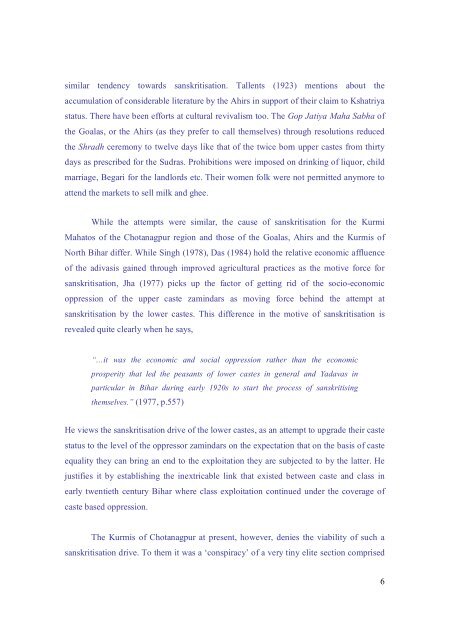Ethnicisation or Re-ethnicisation? Case of the Kurmi-Mahatos in ...
Ethnicisation or Re-ethnicisation? Case of the Kurmi-Mahatos in ...
Ethnicisation or Re-ethnicisation? Case of the Kurmi-Mahatos in ...
Create successful ePaper yourself
Turn your PDF publications into a flip-book with our unique Google optimized e-Paper software.
similar tendency towards sanskritisation. Tallents (1923) mentions about <strong>the</strong><br />
accumulation <strong>of</strong> considerable literature by <strong>the</strong> Ahirs <strong>in</strong> supp<strong>or</strong>t <strong>of</strong> <strong>the</strong>ir claim to Kshatriya<br />
status. There have been eff<strong>or</strong>ts at cultural revivalism too. The Gop Jatiya Maha Sabha <strong>of</strong><br />
<strong>the</strong> Goalas, <strong>or</strong> <strong>the</strong> Ahirs (as <strong>the</strong>y prefer to call <strong>the</strong>mselves) through resolutions reduced<br />
<strong>the</strong> Shradh ceremony to twelve days like that <strong>of</strong> <strong>the</strong> twice b<strong>or</strong>n upper castes from thirty<br />
days as prescribed f<strong>or</strong> <strong>the</strong> Sudras. Prohibitions were imposed on dr<strong>in</strong>k<strong>in</strong>g <strong>of</strong> liqu<strong>or</strong>, child<br />
marriage, Begari f<strong>or</strong> <strong>the</strong> landl<strong>or</strong>ds etc. Their women folk were not permitted anym<strong>or</strong>e to<br />
attend <strong>the</strong> markets to sell milk and ghee.<br />
While <strong>the</strong> attempts were similar, <strong>the</strong> cause <strong>of</strong> sanskritisation f<strong>or</strong> <strong>the</strong> <strong>Kurmi</strong><br />
<strong>Mahatos</strong> <strong>of</strong> <strong>the</strong> Chotanagpur region and those <strong>of</strong> <strong>the</strong> Goalas, Ahirs and <strong>the</strong> <strong>Kurmi</strong>s <strong>of</strong><br />
N<strong>or</strong>th Bihar differ. While S<strong>in</strong>gh (1978), Das (1984) hold <strong>the</strong> relative economic affluence<br />
<strong>of</strong> <strong>the</strong> adivasis ga<strong>in</strong>ed through improved agricultural practices as <strong>the</strong> motive f<strong>or</strong>ce f<strong>or</strong><br />
sanskritisation, Jha (1977) picks up <strong>the</strong> fact<strong>or</strong> <strong>of</strong> gett<strong>in</strong>g rid <strong>of</strong> <strong>the</strong> socio-economic<br />
oppression <strong>of</strong> <strong>the</strong> upper caste zam<strong>in</strong>dars as mov<strong>in</strong>g f<strong>or</strong>ce beh<strong>in</strong>d <strong>the</strong> attempt at<br />
sanskritisation by <strong>the</strong> lower castes. This difference <strong>in</strong> <strong>the</strong> motive <strong>of</strong> sanskritisation is<br />
revealed quite clearly when he says,<br />
“…it was <strong>the</strong> economic and social oppression ra<strong>the</strong>r than <strong>the</strong> economic<br />
prosperity that led <strong>the</strong> peasants <strong>of</strong> lower castes <strong>in</strong> general and Yadavas <strong>in</strong><br />
particular <strong>in</strong> Bihar dur<strong>in</strong>g early 1920s to start <strong>the</strong> process <strong>of</strong> sanskritis<strong>in</strong>g<br />
<strong>the</strong>mselves.” (1977, p.557)<br />
He views <strong>the</strong> sanskritisation drive <strong>of</strong> <strong>the</strong> lower castes, as an attempt to upgrade <strong>the</strong>ir caste<br />
status to <strong>the</strong> level <strong>of</strong> <strong>the</strong> oppress<strong>or</strong> zam<strong>in</strong>dars on <strong>the</strong> expectation that on <strong>the</strong> basis <strong>of</strong> caste<br />
equality <strong>the</strong>y can br<strong>in</strong>g an end to <strong>the</strong> exploitation <strong>the</strong>y are subjected to by <strong>the</strong> latter. He<br />
justifies it by establish<strong>in</strong>g <strong>the</strong> <strong>in</strong>extricable l<strong>in</strong>k that existed between caste and class <strong>in</strong><br />
early twentieth century Bihar where class exploitation cont<strong>in</strong>ued under <strong>the</strong> coverage <strong>of</strong><br />
caste based oppression.<br />
The <strong>Kurmi</strong>s <strong>of</strong> Chotanagpur at present, however, denies <strong>the</strong> viability <strong>of</strong> such a<br />
sanskritisation drive. To <strong>the</strong>m it was a ‘conspiracy’ <strong>of</strong> a very t<strong>in</strong>y elite section comprised<br />
6
















